
Head Surgery Page Menu: 1 2 3 4 5 6 7 8 9 10 11 12 13 14 Next>>
Head Surgery During the Golden Age of Piracy, Page 8
Trepanning Preparation
A number of things were done to prepare both the surgeon and the patient for drilling holes in the skull. Because this was such a dangerous operation for the patient, one of the sea surgeons recommended that surgeons in training practice the operation. In addition to some of the relevant pre-operative steps already discussed for preparing a patient for operations on the head (which include bleeding the patient and shaving their head) there were some steps taken to ready the patient specifically for trepanation. An important consideration was where the hole was to be drilled. Once determined, the scalp may have required further cutting (in addition to any cutting that may have been done to search for the fracture) so that the trepan could be properly set and used on the skull. Some further steps were then required to ready the trepanning site. Let's look closer at these preparatory steps for trepanning.
Trepanning Preparation: Practicing
Sea surgeon John Woodall suggested that his readers - who were surgeon's mates or medically trained assistants to the surgeon - practice trepanning. In the first edition of his book the surgions

"You want to do what, now?"
mate, he said "I.... advise a young Artist to make some experience first upon a Calves head, or a sheepes head till he can well & easily take out a peece the bone; so shall he the more safely doe it to a man without error when occasion is."1
Woodall apparently thought this significant because he expanded upon it quite a bit in a later edition of the book when he was introducing his own version of the trepanning tool which he named the trefine. He recommended that
every young Artist take some convenient time before hand, to make tryall of his Trafine, as is said, upon a Calves-head, or the like subject, before he put it in practice upon a man, for a good Surgeon may erre, even in a small omission in such a businesse to his griefe and reproach, if hee be not exceeding cautious, and for that cause I advise every young Surgeon (as is said) to suspect himself, and warily to consider that the precious life of man so dependeth upon the care, wisedome, and artificall skill of the Surgeon in his worke, as that upon a small omission or errour of forgetfulnesse, or but a very little mistake, a man is in a moment slaine by art, for want of art, when it will be too late for the Artist within himself, to ruminate of the things that most conduced to the mischief, and upon all occasions, or omissions whatsoever befalling the Artist, let him ever be fearefull and carefull of entering too deepe, for feare of wounding, or but scratching of the (Dura Mater) for those transgressions often produce fearefull accidents and deadly.2
None of the other sea surgeons discussed practicing the operation. Of course, John Atkins was generally opposed to trepanning and John Moyle focused more on the practical steps than theory. But John Woodall's was the first book devoted specifically to training sea surgeons and he recognized that practice would be valuable for teaching his students how the trepan worked and reacted.
1 John Woodall, the surgions mate, 1617, p. 6; 2 Woodall, the surgions mate, 1639, p. 317
Trepanning Preparation: Readying the Instruments and Patient
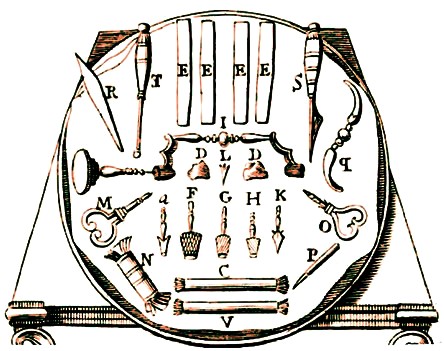
Trepanning Operation Instruments, Pierre Dionis, A course of
chirurgical operations (1708)
The Trepan (I) and the various blades (a & F-L)
are in the center. The other instruments
will be explained as the are encountered in the remainder of this article.
French surgical instructor Pierre Dionis provides detailed instructions on how to prepare for a trepanning operation. He begins by explaining a method for setting up the tools to be used. "The Instruments are to be prepar’d in an adjoining Chamber, and rang’d in order in a broad Dish or Bason, cover’d with a folded Napkin, after which it must be cover’d with another Napkin, before ‘tis brought into the Patient’s Chamber, that he may not be affrighted at the Sight of them."1
Dionis doesn't detail the specific instruments to be used in a single place in his text, preferring to reference them as they are mentioned in his operative procedure. However, the instruments he includes are shown at left for reference. Most will be discussed in greater detail later.
Dionis goes on to give instructions for how the surgeon should prepare himself and his patient for the operation. (A paragraph break has been added to the original text to make it more readable.)
The Patient is to be situated in a convenient Posture, that is, his Head so turn’d that the Wound is uppermost and high, in order to sustain the Trepan perpendicularly plac’d on it. The Bed is to be remov’d into the [operating] Chamber, that a Servant may Lie at the Bed’s head, in order to hold the Patient’s Head the firmer; and if the Operator judges that Place more commodious for him, he places himself there; the Patient’s Head is to be laid upon a Pillow, under which is thrust a small Board to hinder its sinking during the Operation.
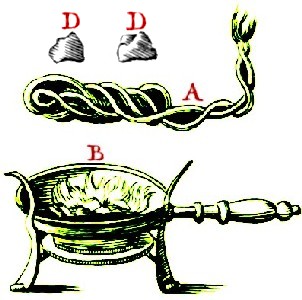
Chafing Dish, Wick & Cotton, Pierre Dionis, A course of
chirurgical operations (1708)
The Chirurgeon then causes his Hair to be ty’d behind him, that it may not fall across his Eyes when he stoops; and if he has a Peruke [wig], he takes it off, and puts on a little Cap, which will not at all hinder him: And whilst some Attendant holds Fire in a Chaffing-Dish B, in the middle of the Bed, he must cause to be lighted the two small Wax-Lights A, join’d and twisted together, that they may not give two separate Lights; these twisting Wax-Lights are better than others, because they easily bend, and may be drawn near to, or kept at a Distance from the Operator, as may be found necessary. ...the Ears of the Patient are stopp’d with the two little Balls D,D, of Cotton or Lint. I believe, that the Noise which rises in the Ears when they are stopp’d, hinders the small Noise which the Crown of the Trepan makes in sawing the Skull; but I have seen this Ceremony forgotten, and the patient never the Worse.2
Although Dionis doesn't specifically explain the presence of the chafing dish other than for lighting wicks, sea surgeon John Woodall mentions in his book that "All things therefore in readinesse, and the Patient placed close and warme from the ayre"3. Woodall also mentions having two assistants "appointed to stay [the patient's] head" during the operation instead of just one as Dionis suggests.4 Like Dionis, sea surgeon John Atkins notes, "It is usual to stop the Ears with Cotton, for preventing an ungrateful Sensation"5.
Dionis also recommends that the surgeon prepare "the Necessaries requir’d to the dressing the Patient after that [trepanning] is over: Wherefore he is to prepare two Basons, in the first of which he is to dispose the Instruments [used during trepanning], and in the second he is to place whatever is necessary to the Dressing [of the operation site]"6.1 Pierre Dionis, A course of chirurgical operations: demonstrated in the royal garden at Paris. 2nd ed., p. 282; 2 Dionis, p. 282-3; 3,4 John Woodall, the surgions mate, 1617, p. 5; 5 John Atkins, The Navy Surgeon, 1742, p. 86; 6 Dionis, p. 281
Trepanning Preparation: Choosing the Location
“But you must take care where you apply the trepan, and see that you do so only where it appears to be particularly thick..." (Hippocrates, On Injuries of the Head, p. 466)
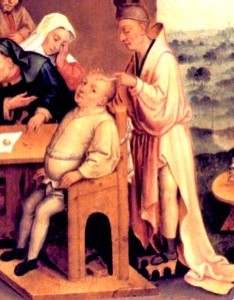
Artist: Hieronymus Bosch
Surgeon Examining the Skull (~1550)
Deciding where to make the hole in the skull was important for the effectiveness of the operation. Sea surgeon John Atkins explains that the hole was to be made "near the Fracture, in order to raise any Part of the Bone depressed depending, for the more favourable Discharge of what is extravasated"1. Atkins elsewhere explains that the trepan placement should not be "on, or night, the Temples, Sutures [of the skull], or Productions in the middle of the Occipital or Cornoral [Frontal] Bones, because the Dura Mater strictly adheres to them, and there would be Danger of tearing it with the Instrument."2
Fellow sea surgeon John Woodall also recommended boring near the fracture, commenting that the trepan location should "be set upon a firme part of the Cranium or scull, yet alwayes provided it be neare the fractured part thereof as may be."3 The cutting action
of a trepan depended upon downward pressure on the tool. If this pressure were applied to the tool
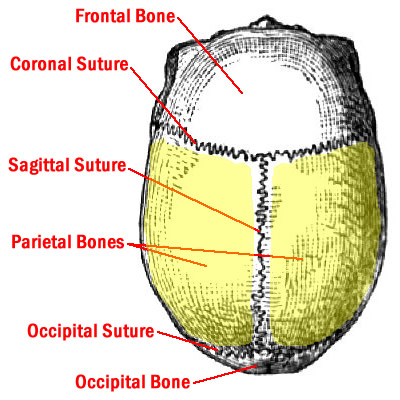
Sutures & Bones on the Top of the Skull. The yellow area is where a trepan
could be applied according to the period sea surgeons.
when it was placed on an unsound, damaged portion of the fractured skull, the surgeon would be pushing the broken bone into the brain, possibly causing more bleeding and most likely damaging the brain.
While echoing Atkins' comments, sea surgeon John Moyle provided a little more information about the trepan's placement relative to the fracture in the skull. He tells the surgeon, "you must not apply it on the Fissure, but besides or beneath the Fissure, as near the depending part thereof as possible, that the Blood may the better be evacuated. And have a care you mistake not a Suture of the Skull for a Fracture. Nor must you apply your Traphine [trefine] on Sutures, or Temporal Bones, or Sinciput [Frontal bone]."4
Of course, none of these descriptions are terribly specific. Exact locations would be impossible to give since the hole must be made relative to the fracture in the skull based on the surgeon's judgment. However it should be clear that the skull must be trepanned close to the fracture on bone that isn't so badly damaged that the pressure will create further problems. If one of the purposes of trepanning is to raise up a depression in the skull, the hole must be close enough to do so.
1 John Atkins, The Navy Surgeon, 1742, p. 85; 2 Atkins, p. ; 3 John Woodall, the surgions mate, 1639, p. 315; 4 John Moyle, The Sea Chirurgeon, 1693, p. 10
Trepanning Preparation: Cutting the Scalp
"In order to the Perforation of the Cranium, the Bone must be cleared of its Pericranium, lest in setting on the Terebra, or Modiolus, (which are two several names for a Trepan,) you tear the Membrane." (Richard Wiseman, Of Wounds, Severall Chirurgicall Treatises, 1676, p. 381)
The scalp was likely to have been previously cut to search for a fracture or improve the ability to view or work on an existing wound as discussed previously. However, more cutting could be required to bare the skull in preparation for trepanning as Wiseman's quote indicates. French surgical instructor Pierre Dionis similarly comments "Where there are Signs the Bone is hurt, and we think it necessary to use the Trepan, if the Wound is not large enough to apply it, we must dilate it [cut it open further]."1
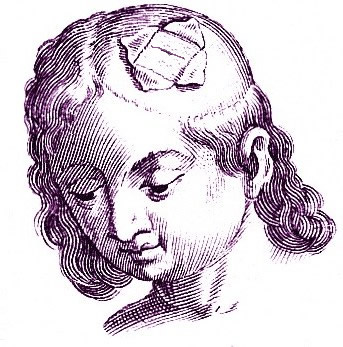
Artist: Jonas Arnold Delineavi
The 'Pie Slice' Cuts to Prepare for Trepanning, From
Armamentarium
Chirurgicum Bipartitum,
by Johannes
Scultetus (1666)
Sea surgeon John Woodall agrees that the wound may need to be opened, although he tempers his recommendation with a warning: "Note also that where a fracture is accompanied with a wound, it shall not be needful to inlarge further then will serve to set the Trapan; for as too little breathing is dangerous, so are too great wounds; making the Artist to be esteemed Butcher-like and hatefull, and is often also very dangerous and deadly."2
In a section on trepanning added to a later edition of his book, Woodall adds "that as too small incision is not good, that the Surgeon [should] ever have regard to preserve the beauty of nature as much as may be"3. He goes on to explain that particular care should be had for incisions near the temples or forehead, two places forbidden to be trepanned by Moyle and Atkins.
While the method for making the cut was discussed previously in the section on Dilating or Opening the Wound, some surgeons give instructions for making a specific type of cut for the trepan, which would require a space large enough to keep the skin clear of the round trepan blade.
Sea surgeon John Atkins says, "The Night before the Operation we are to make our Way clear to the Skull [using incision], by extending either Line of the cross Incision, (supposed to have been made at first,) and separating entirely one or more of the Angles, as shall be thought requisite to answer the Purpose before us."4 Atkins comment is a bit confusing. Presumably the 'cross incision' refers to an incision made across the the skull fracture when either searching for or baring an existing fracture. The 'Angles' likely refer to the wedge-shaped pieces of skin made by incisions as seen above left. Atkins' point is that the surgeon needs to to increase the size of the existing incisions in a way that would provide more room for placing the trepan.
Dionis provides a number of suggestions for making the incision in preparation for trepanning, with explanations for where each type of cut is appropriate.
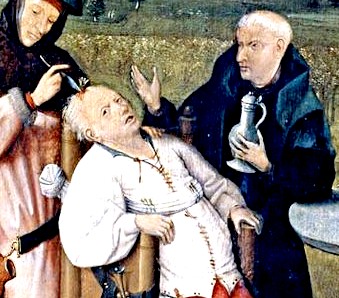
Artist: Hieronymus Bosch
Surgeon Cutting the Scalp (14th c.)
The Incisions used in these sorts of wounds, must be made in the shape of an X, a T, an N, or the numerical Figure 7: These are the most common Figures which we give to these Incisions, according to the Nature of the Wound. Those formed like an X, which are also called cross ones, from their Resemblance to a Cross, are made on the middle of the Coronal [Frontal] Bone and the Parietales. When the Wound approaches some Suture, the Incision is made like a T, cutting that Branch of the Wound nearest the Suture; but we also prolong the opposite Branch, in order sufficiently to discover [open to allow access to] the Skull. Those made near the Temporal Muscle, or the Sutures, are shap'd like an V, or Figure of 7, to avoid the stripping of the Parts: But in general we comply with the Figure and Situation of the Wound, which does not always permit us to shape it as we please.5
It is interesting that Dionis recommends incisions specifically used to cut in several locations that our sea surgeons forbade including the frontal and temporal bones. Of course, Dionis was a land-based surgical instructor who would have been likely to present all possible surgical situations. It may have been that the sea surgeons didn't want to attempt more delicate operations or that they may not have been familiar or trained in such operations.
1 Pierre Dionis, A course of chirurgical operations: demonstrated in the royal garden at Paris. 2nd ed., p. 274; 2 John Woodall, the surgions mate, 1617, p. 6; 3 John Woodall, the surgions mate, 1639, p. 317; 4 John Atkins, The Navy Surgeon, 1742, p. 86; 5 Dionis, p. 274
Trepanning Preparation: Readying the Site
After discussing the incision, a few surgeons mention other steps to prepare the site for trepanning. In one of his case studies, sea surgeon John Moyle explains how "the Mucronata of the Incisure (which had their Center in the Wound) were clipp’d off with Probe-Scissars, to make the better way for the Operations which were to follow."1 Moyle is suggesting the surgeon cut off sharp points of bone located in the center of the bone. ('Mucranata' is Latin for 'pointed ends' and 'incisure' refers to notches in the surface of something).
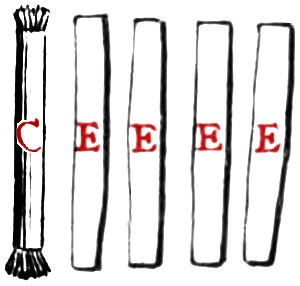
False Lintent Tent and Small Bands, Pierre Dionis, A course
of
chirurgical operations (1708)
Protecting the flesh at the edges of the opened skull was another important concern. Military surgeon Richard Wiseman suggests "The Lips of the Wound ought also to be covered" during trepanning to protect them from the blade.2
French surgical instructor Pierre Dionis explains that the surgeon "must not touch the Lips of the Wound of the Pericranium, which would give the Patient a most sensible Pain in the Operation"3. He provides a more holistic approach to the problem, first cleansing the cut edges of the skin "with the false Lintent Tent C, to render the Operation less painful"4. He then advises,
If the Lips of the Wound are not sufficiently rais’d [from the bone to be trepanned], and are in danger of touching the Teeth of the Crown, we must, with the four small Bands E E E E, thrust under them, and whose ends we cause to be held by the Apprentice who hold the [patient's] Head, or some other Youth, separate them from one another; but if the Wound is sufficiently dilated [cut open], and so wide that the Lips don’t touch the Instrument, we are without loss of Time to prepare for the Operation."5
Dionis' comment is reminiscent of Johannes Scultetus' suggestion that the incised edges of the skull to be raised up with a trefoil be kept open 'with pellets'6.
1 John Moyle, Memoirs: Of many Extraordinary Cures, 1708, p. 2; 2 Richard Wiseman, Of Wounds, Severall Chirurgicall Treatises, 1676, p. 381; 3,4,5 Pierre Dionis, A course of chirurgical operations: demonstrated in the royal garden at Paris. 2nd ed., p. 283; 6 See Johannes Scultetus, The Chirurgeons storehouse, 1674, p. 128;

